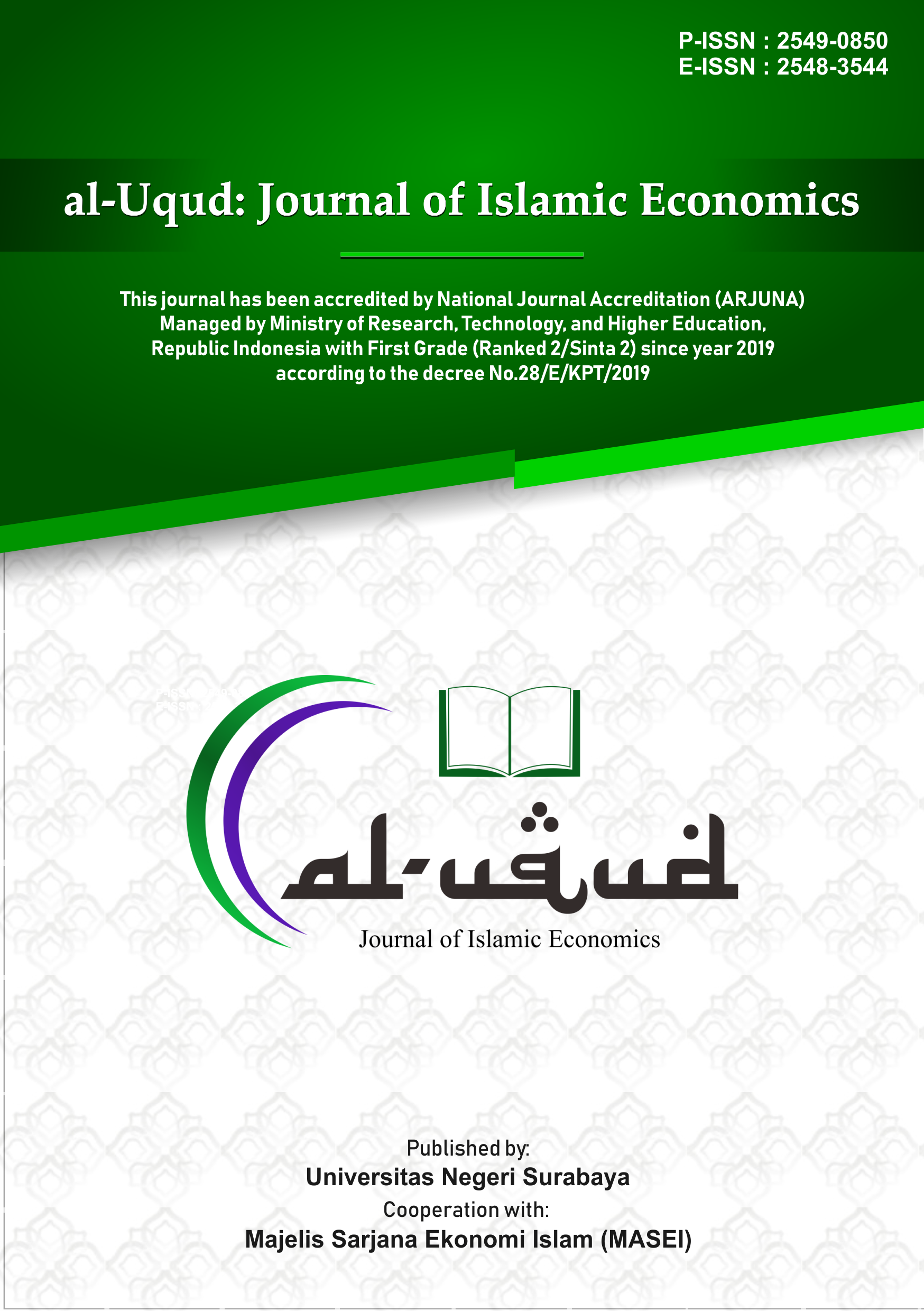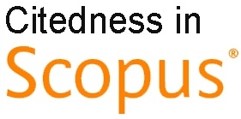The Synergy Model for Strengthening the Productivity of Indonesian Halal Industry
DOI:
https://doi.org/10.26740/al-uqud.v4n2.p186-199Keywords:
Synergy, Productivity, Halal Industry, BPJH, MUI.Abstract
Halal industry has become a new commodity that is favoured by all countries around the world, including Indonesia. The main challenge of halal industry development is strengthening its position as a producer in the global halal industry market. This study aims to investigate the number of policy proposals relating to strengthening the productivity of the halal industry in Indonesia and then develop a model of synergy over this matter. This study uses a qualitative study approach, with literature review, observation and interview as data collection methods. The results obtained from this study include several things, specifically; the focus of economic development in Indonesia is fundamentally still focused on the processed industry, which incidentally is dominated by imported raw materials. Based on the results of the analysis of the discussion, the implications of these studies is providing input for authorities such as BPJH, MUI and related ministries to adjust the regulation that address the main business challenge of halal industry. Besides, the government should give special authority to state-owned and private sharia banks to finance the halal industries and agricultural to support their sustainable development.
References
Afifi, M., Wati, K., Syed, T., Najib, M., Omar, S., Ahmad, A., Alisa, A., Izhar, M., & Kashim, M. (2014). Consumer Protection of Halal Products In Malaysia¯: A Literature Highlight. Procedia - Social and Behavioral Sciences, 121 (September 2012), 6878. https://doi.org/10.1016/j.sbspro.2014.01.1109
Alam, N., Gupta, L., & Shanmugam, B. (2017). Islamic finance: A practical perspective. In Islamic Finance: A Practical Perspective. https://doi.org/10.1007/978-3-319-66559-7
Ali, A., Xiaoling, G., Sherwani, M., & Ali, A. (2017). Factors affecting Halal meat purchase intention: Evidence from international Muslim students in China. British Food Journal, 119(3), 527541. https://doi.org/10.1108/BFJ-10-2016-0455
Antara, P. M., Musa, R., & Hassan, F. (2016). Bridging Islamic Financial Literacy and Halal Literacy¯: The Way Forward in Halal Ecosystem. Procedia Economics and Finance, 37(16), 196202. https://doi.org/10.1016/S2212-5671(16)30113-7
Anwar, M. K., Fahrullah, A., & Ridlwan, A. A. (2017). Sertifikasi Halal Sebagai Upaya Perlindungan Konsumen Muslim (Studi pada Lembaga Pengkajian Pangan Obat-obatan dan Kosmetika Majelis Ulama Indonesia Provinsi Jawa Timur). Prosiding Seminar Nasional PPM Universitas Negeri Surabaya, 538545.
Anwar, M. K., Fahrullah, A., & Ridlwan, A. A. (2018). the Problems of Halal Certification. International Journal of Civil Engineering and Technology (IJCIET), 9(8), 16251632. http://www.iaeme.com/MasterAdmin/Journal_uploads/IJCIET/VOLUME_9_ISSUE_8/IJCIET_09_08_162.pdf
Aprizal, A., Mirdhayati, I., & Yendraliza, Y. (2019). Physical and Chemical Characteristic of Halal Gelatin Extracted from Buffalo Hide with Addition of Pineapple Rind at Different Ratio. Indonesian Journal of Halal Research, 1(1), 14. https://doi.org/10.15575/ijhar.v1i1.4109
Battour, M., Hakimian, F., & Ismail, M. (2018). The perception of non-Muslim tourists towards halal tourism. 9(4), 823840. https://doi.org/10.1108/JIMA-07-2017-0072
Chitrakorn, K. (2015). Can Halal Cosmetics Outgrow Their Niche? BoF.
Davies, R. (2015). Industry 4.0. Digitalisation for productivity and growth. European Parliamentary Research Service.
Habibi, M. L., & Yudha, A. T. R. C (2017). Membangun Integrated Takaful dan Wakaf Model dalam Upaya Meningkatkan Kemanfaatan Pemegang Polis. al-Uqud: Journal of Islamic Economics. 1(2), 139155. http://dx.doi.org/10.26740/al-uqud.v1n2.p139-155
Haleem, A., & Khan, M. I. (2017). Towards successful adoption of Halal logistics and its implications for the stakeholders. British Food Journal, 119(7), 15921605. https://doi.org/10.1108/BFJ-12-2016-0637
Hegnes, A. W. (2019). The map and the terroir: Adapting geographical boundaries for PDO and PGI in Norway. British Food Journal, 121(12), 30243042.
Hong, M., Sun, S., Beg, A. B. M. R., & Zhou, Z. (2019). Determinants of halal purchasing behaviour: evidences from China. Journal of Islamic Marketing, 10(2), 410425. https://doi.org/10.1108/JIMA-03-2018-0053
Hudaefi, F. A., & Jaswir, I. (2019). Halal Governance in Indonesia: Theory, Current Practices, and Related Issues. Journal of Islamic Monetary Economics and Finance, 5(1), 89116. https://doi.org/10.21098/jimf.v5i1.1049
Ishak, S., Awang, A. H., Hussain, M. Y., Ramli, Z., Md Sum, S., Saad, S., & Abd Manaf, A. (2016). A study on the mediating role of halal perception: determinants and consequence reflections. Journal of Islamic Marketing, 7(3), 288302. https://doi.org/10.1108/JIMA-02-2015-0010
Kamaruddin, R., Iberahim, H., & Shabudin, A. (2012). Willingness to Pay for Halal Logistics¯: The lifestyle choice. 50(July), 722729. https://doi.org/10.1016/j.sbspro.2012.08.075
Khasanah, N. N., Amalia, V., El Viera, B. V., & Sawitri, A. (2019). Na-Alginate Utilization of Brown Algae (Sargassum sp.) as A Halal Edible Film Basic Materials. Indonesian Journal of Halal Research, 1(1), 913. https://doi.org/10.15575/ijhar.v1i1.4242
Kulsum, Y., Adawiyah, A., Shofwaturrohmani, F., & Nurjanah, D. (2019). Pig Sample Handling in Research Laboratory Scale. Indonesian Journal of Halal Research, 1(1), 1417. https://doi.org/10.15575/ijhar.v1i1.4091
Majid, R., & Agassi, B. A. (2017). HASBLE Card¯: Innovation on Company Funding Using Shariah Venture Capital toward Halal Industry in Indonesia. Journal of Islamic Finance, 6(Special Issue), 242256. https://doi.org/10.12816/0047352
Manager, B. S., & Reuters, T. (n.d.). Digital islamic economy overview.
Mohd Nawawi, M. S. A., Abu-Hussin, M. F., Faid, M. S., Pauzi, N., Man, S., & Mohd Sabri, N. (2019). The emergence of halal food industry in non-Muslim countries: a case study of Thailand. Journal of Islamic Marketing. https://doi.org/10.1108/JIMA-05-2018-0082
Muhamad, N., Leong, V. S., & Md Isa, N. (2017). Does the country of origin of a halal logo matter? The case of packaged food purchases. Review of International Business and Strategy, 27(4), 484500. https://doi.org/10.1108/RIBS-06-2017-0049
Muhamed, A. A., Ab Rahman, M. N., Mohd Hamzah, F., Che Mohd Zain, C. R., & Zailani, S. (2019). The impact of consumption value on consumer behaviour: A case study of halal-certified food supplies. British Food Journal, 121(11), 29512966. https://doi.org/10.1108/BFJ-10-2018-0692
Murti, T. W. (2017). Halal Life Style And Global Trade. The 7th International Seminar on Tropical Animal Production Contribution of Livestock Production on Food Sovereignty in Tropical Countries, 2, 3339. https://journal.ugm.ac.id/istapproceeding/article/view/30115
Naeem, S., & Ayyub, R. M. (2019). Systematic literature review of halal food. https://doi.org/10.1108/JIMA-09-2018-0163
Oseni, U. A., Ali, S. N., & de Anca, C. (2019). Fintech in Islamic finance. In Fintech In Islamic Finance. https://doi.org/10.4324/9781351025584-4
Park, M., & Jamaludin, M. A. (2018). A Framework of Halal Industry Support System in non-Muslim Country¯: A Focus on South Korea. Journal of Halal Industry and Service, 1(1), 114.
Rahman, F. K. (2017). Maqashid Al-Shari ah -based performance measurement for the halal industry. 33(3), 357370. https://doi.org/10.1108/H-03-2017-0054
Reuters, T. (2018). State of Global Islamic Economy Report 2018/19. In Dubai International Financial Centre.
Ryandono, M. N. H., & Ridlwan, A. A. (2020). Solution for Islamic Banks Exploitation: A Criticism of Fixed-Yields Based Financing in Indonesia. Al-Uqud: Journal of Islamic Economics, 4(1), 4868. http://dx.doi.org/10.26740/al-uqud.v4n1.p48-68
Salman, A. M., Halim, A., Rohman, N., & Susilayati, M. (2019). œHalal As a Competitive Distinction for Islamic Higher Education in Preparing Muslim Millenials. Indonesian Journal of Islamic Literature and Muslim Society, 3(2), 111. https://doi.org/10.22515/islimus.v3i2.1922
Salman, A. S. (2018). Non-Muslims acceptance of imported products with halal logo. 9(1), 191203. https://doi.org/10.1108/JIMA-02-2016-0009
Satya, V. E. (2018). Strategi Indonesia Menghadapi Industri 4.0. Kajian Singkat Terhadap Isu Aktual Dan Strategis.
Shaari, M. N. (2018). Revolusi industri 4.0: Suatu Pengenalan. Abatan Perdana Menteri.
Sukesi, & Hidayat, W. G. P. (2019). Managing the Halal industry and the purchase intention of Indonesian Muslims the case of Wardah cosmetics. Journal of Indonesian Islam, 13(1), 200229. https://doi.org/10.15642/JIIS.2019.13.1.200-229
Swidi, A., Wie, C., Hassan, M. G., Hosam, A. A., & Kassim, A. W. K. (2010). The Mainstream Cosmetics Industry in Malaysia And The Emergence, Growth, And Prospects of Halal Cosmetics. Proc. the Third International Conference on International Studies.
Takeshita, S. (2019). Halal certification or ingredient disclosure: A comparative analysis of serving food in Japanese tourist destinations. Journal of Islamic Marketing, 03417(15). https://doi.org/10.1108/JIMA-07-2018-0129
Tan, K. H. (2017). The impact of external integration on halal food integrity. 2(April), 186199. https://doi.org/10.1108/SCM-05-2016-0171
Thomson Reuters and Dinar Standard. (2018). State of the Global Islamic Economy Report 2019/20. Dubai International Financial Centre.
Tieman, M. (2011). The application of Halal in supply chain management¯: in-depth interviews. https://doi.org/10.1108/17590831111139893
Tieman, M. (2019). Measuring corporate halal reputation A corporate halal reputation index and. https://doi.org/10.1108/JIMA-05-2018-0095
Tieman, M., & Ghazali, M. C. (2012). Principles in halal supply chain management. 3(3), 217243. https://doi.org/10.1108/17590831211259727
Toni, A. (2020). Profesionalisme dosen luar biasa (DLB) pada era milenial di uin sunan ampel surabaya: sebuah studi analisis konten. 2, 7786.
Wahyu, M., & Sheikh, F. (2016). Non-Muslim Consumers Halal Food Product Acceptance Model. Procedia Economics and Finance, 37(16), 276283. https://doi.org/10.1016/S2212-5671(16)30125-3
Wingett, F., & Turnbull, S. (2020). Halal holidays¯: exploring expectations of Muslim-friendly holidays. https://doi.org/10.1108/JIMA-01-2016-0002
Yudha, A. T. R. C., & Dusturiya, N. (2018). Model Pengembangan Kewirausahaan Sosial Berbasis Mahasiswa pada Lembaga Amil Zakat. El-Qist, 8(1), 16181637.
Yudha, A. T. R. C., Ryandono, M. N. H., Rijal, A., & Wijayanti, I. (2020). Financing model to develop local commodity business of East Java in Maqashid Syariah perspective. Test Engineering and Management, 83(3590), 35903595.
Zaki, I., Widiastuti, T., Yudha, A. T. R. C., Wijayanti, I., & Miraj, D. A. (2020). Implementation of Islamic entrepreneurial culture in Islamic boarding schools. International Journal of Innovation, Creativity and Change, 11(11), 452469.
Downloads
Published
How to Cite
Issue
Section
License
CC BY 4.0 Abstract views: 1406
,
Abstract views: 1406
, PDF Downloads: 973
PDF Downloads: 973








